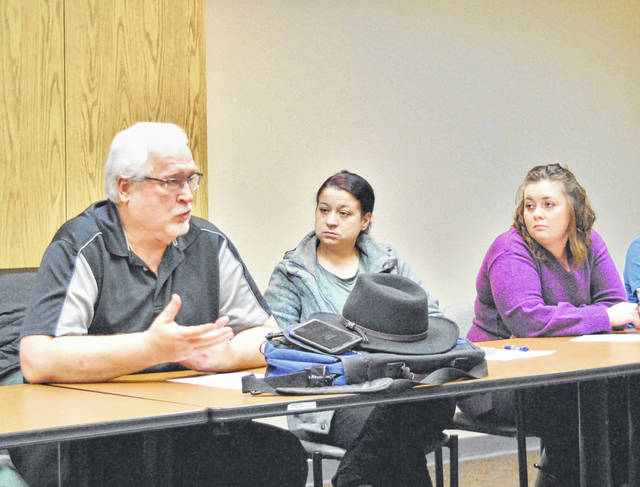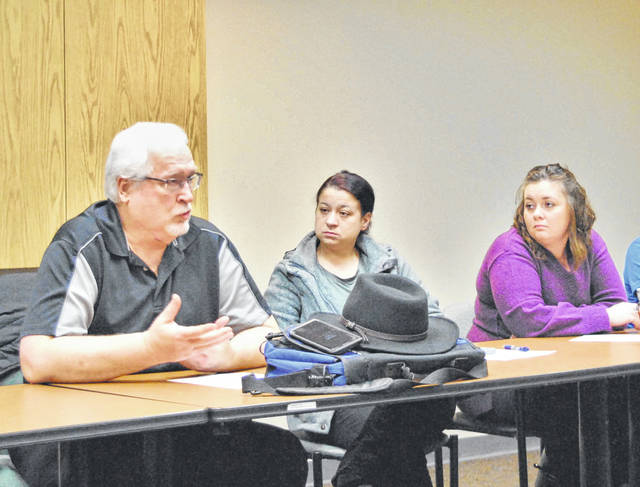

Jack Stem, a former nurse anesthetist and recovering addict, spoke about medical professionals and addiction at Thursday’s Highland County Drug Abuse Prevention Coalition meeting.
Stem, who has been clean for more than 15 years, shared the story of his struggle with addiction.
“I started working as a registered nurse in the emergency room at Christ Hospital, and one of the things that I discovered was that I hated drug addicts — they came in looking for their drugs, and if I told one, I told thousands: ‘If you loved your family, you’d stop doing this. You clearly love your drugs more than you love your family,’” Stem said. “And then one day, I discovered I loved my family, and I couldn’t stop doing it.”
Stem had a chronic pain condition and had been taking his pain medication as prescribed for around 15 years. In 1989, his pain worsened and after his doctors and the residents at the hospital he worked at stopped writing him prescriptions, Stem began taking medication from his hospital.
“I remember the day I looked at the leftover fentanyl that I was going to squirt down the drain, which is what we did then, and thought it made perfect sense to take that home for pain control. It had nothing to do with being high, it had nothing to do with escaping — I needed pain management,” Stem said. “What I’ve discovered in my 25 years of recovery, being a counselor, peer assistance advisor, and studying this is that the changes that occur in the brain are so dramatic that we don’t even know they’re happening. I learned a new term a few years ago: anosognosia, which means you’re not aware that you’re ill. So you’re looking at someone like Alzheimer’s and maybe traumatic brain injuries — as far as they’re concerned they’re fine. Everyone else around them can see.
“It wasn’t a conscious denial that I had an issue — I didn’t think I had an issue. As soon as the pain was fine, I was going to stop using, and everything would be OK.”
Stem began by injecting fentanyl intramuscularly, increasing the dosage as his tolerance grew. The amount he was injecting quickly became painful, and he switched to intravenous injections.
“The more potent a drug is, the faster the tolerance builds,” Stem said. “It got so bad that I switched to a drug called sufentanil, which is super fentanyl — it’s 10 times stronger than fentanyl. In a very short period of time, I was taking huge amounts, and I was still going to work and doing anesthesia, using multiple times throughout the day and night.
“I had just become the chief nurse anesthetist in labor and delivery, I was at the peak of my career, and I had this secret.”
Afraid that his family would suffer if he got caught abusing fentanyl, Stem decided the best way to prevent that was to die.
He prepared what he said was enough sufentanil to kill five people, but when he went to the locker room to inject it, someone else came in and started throwing and kicking things. Stem waited for the man, who he assumed was a resident, to calm down.
“I’m thinking, ‘He has to run out of steam,’ but he didn’t,” Stem said. “Finally, I looked at the syringe and thought, ‘What are you doing, man? You have two kids at home. This is stupid,’ so I squirted the medication down the drain.”
Two days later, Stem had a semi-emergency spinal fusion.
“My dad told me, after the surgery, the anesthesiologist came out and said, ‘Man, he must have been in a lot of pain because we’ve never given anybody that much medication in my career,’” Stem said. “I was using the equivalent of 300 milligrams of morphine every three hours every day for months. My tolerance was pretty high.”
Stem was off work to recover from his surgery for the next five months, during which he said he never thought of using.
“The first day back in the operating room, I popped that first vial of fentanyl to get ready and broke into a sweat. I thought I was going to vomit,” Stem said. “It was a major trigger, which shocked the hell out of me. They don’t teach us about addiction in nursing school or medical school or anesthesia school, so this was all bizarre to me, but I was obsessed with using from that point on. I had a plan for how I was going to control it this time.”
Soon after, Stem’s youngest daughter, who was 4 at the time, found Stem after he overdosed. She told her mom, “Daddy’s a funny color.”
“My wife was an ICU nurse, and she thought, ‘I probably should go and check on him,’” Stem said. “She said I was purple. She started mouth-to-mouth, and my 9-year-old daughter had to call 911.”
Stem woke up in an ambulance heading to the hospital he worked at, where he later admitted that he was addicted to fentanyl after trying and failing to come up with an excuse to explain away the results from his toxicology screening. The chief of the department told him to go to treatment and get well.
Stem went through treatment a total of four times and eventually surrendered his medical license in an attempt to stay clean.
After he was arrested and narrowly escaped an eight-year prison sentence, Stem’s sponsor challenged him to go to 90 support group meetings in 90 days.
“We were driving home, and he said, ‘Do what I tell you for the next 90 days, and if your life isn’t significantly better, just use—you’ll get your misery back,’” Stem said. “I think that was the first time I realized I was using, and that’s what made me miserable, not the other way around.”
Stem said his support from his father kept him going while he was recovering, and he found a sense of purpose while working with his oldest daughter’s boyfriend at a landscape company.
In 2003, Stem was invited to speak on addiction and anesthesia at conferences in Michigan and Boston. While speaking in Boston, Stem reconnected with a former student who was then the president of the Ohio State Association of Nurse Anesthetists. She asked him to be a peer assistance advisor.
Since then, he’s worked as a coach for a defense attorney and a counselor. He’s currently a counselor at a treatment center in Cincinnati and a grant manager for a project at the University of Cincinnati.
Stem said he’s grateful for everything he went through because when his youngest daughter became an addict, he was able to support her.
“I guarantee if I hadn’t gone through this, I would’ve blown that, and she would be dead today,” Stem said. “For a while, I was the only support she had. It reminded me very much of my dad and I. I thank God all the time that I did go through it all the time just for her. The things I’ve been able to do as a result of my recovery make what I went through worthwhile.”
Stem said it’s important to educate students and parents instead of using scare tactics. He recommended that those who want to learn more about addiction or how to help loved ones struggling with addiction visit treatment centers like Family Recovery Services (FRS) in Hillsboro or attend support group meetings — even if they aren’t addicted.
The next Highland County Drug Abuse Prevention Coalition will be on March 26 at 11:30 a.m. in the health department conference room, located in the North High Business Center at 1487 N High St. in Hillsboro.
Reach McKenzie Caldwell at 937-402-2570.


